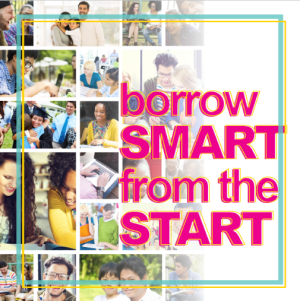When you receive your financial aid offer from your chosen college or university, there may be one or more student loans included in the offer. You can set yourself up for student loan success by borrowing smart from the start. Here are some things you need to know as you consider student loans:
- Complete the FAFSA. If you haven’t already, complete the Free Application for Federal Student Aid (FAFSA) as soon as possible to apply for financial assistance for college. Visit FAFSA.gov to learn more.
- Use ‘free money’ first. Take advantage of grants and scholarships you’re offered; they’re called ‘free money’ because you ordinarily don’t have to pay them back. Schedule a dedicated time each week to search for scholarships. You can begin your search at UCanGo2.org and make use of the Are You Looking for Money? guide.
- You don’t have to accept all student loans you’re offered. If you must borrow money to help cover college expenses, you have the right to accept only what you need after your grant and scholarship funds have been applied to your account. Review your finances each year and commit to borrowing only what you need to cover school expenses.
- Consider a part–time job. Working part-time while in college can significantly reduce the amount of debt you may have when you graduate. If you’re eligible for a federal work-study job, take advantage of it. Working on campus gives you experience and college employers will work around your schedule. You may also visit the campus career center to learn about other types of campus jobs.
- Do your research. Some experts recommend that your monthly loan payment should be no more than 8-10% of the monthly income you expect to earn during the first year after graduation. Visit Oklahoma Employment & Wage Network to estimate your entry-level income after college. To estimate your loan payments, try the Loan Calculator found at ReadySetRepay.org.
- Subsidized student loans are less expensive. Interest isn’t added to a subsidized federal student loan until after you graduate, withdraw or drop your class load to less than half-time status.
- Make interest payments. Students who borrow federal unsubsidized loans are responsible for interest when they receive the first disbursement. If possible, make payments on the interest while you’re in school and during your grace period. To see an example of how this can significantly reduce the amount you have to repay, click here.
- Keep in touch with your loan servicer(s). When your student loan repayment process begins, make sure your loan servicer knows your current address, and contact them if you’re having trouble making your payments. You can find contact information for your servicer by logging in to StudentAid.gov/h/manage-loans using your Federal Student Aid ID (FSA ID).
- Stay informed. Be sure to check out the Borrow Smart from the Start booklet at ReadySetRepay.org. This booklet provides information on the lifecycle of a federal student loan as well as how to successfully manage repayment . You’ll find Borrow Smart from the Start in English and Spanish.
You can set yourself up for success by borrowing smart and using these strategies to make the most of your student loans.

